Sungjun Cho
TARDIS: Mitigating Temporal Misalignment via Representation Steering
Mar 25, 2025Abstract:Language models often struggle with temporal misalignment, performance degradation caused by shifts in the temporal distribution of data. Continuously updating models to avoid degradation is expensive. Can models be adapted without updating model weights? We present TARDIS, an unsupervised representation editing method that addresses this challenge. TARDIS extracts steering vectors from unlabeled data and adjusts the model's representations to better align with the target time period's distribution. Our experiments reveal that TARDIS enhances downstream task performance without the need for fine-tuning, can mitigate temporal misalignment even when exact target time period data is unavailable, and remains efficient even when the temporal information of the target data points is unknown at inference time.
Partial-Multivariate Model for Forecasting
Aug 19, 2024
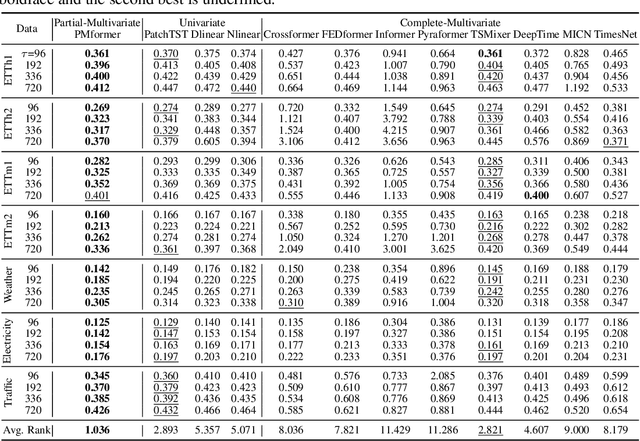


Abstract:When solving forecasting problems including multiple time-series features, existing approaches often fall into two extreme categories, depending on whether to utilize inter-feature information: univariate and complete-multivariate models. Unlike univariate cases which ignore the information, complete-multivariate models compute relationships among a complete set of features. However, despite the potential advantage of leveraging the additional information, complete-multivariate models sometimes underperform univariate ones. Therefore, our research aims to explore a middle ground between these two by introducing what we term Partial-Multivariate models where a neural network captures only partial relationships, that is, dependencies within subsets of all features. To this end, we propose PMformer, a Transformer-based partial-multivariate model, with its training algorithm. We demonstrate that PMformer outperforms various univariate and complete-multivariate models, providing a theoretical rationale and empirical analysis for its superiority. Additionally, by proposing an inference technique for PMformer, the forecasting accuracy is further enhanced. Finally, we highlight other advantages of PMformer: efficiency and robustness under missing features.
Towards Robust and Cost-Efficient Knowledge Unlearning for Large Language Models
Aug 13, 2024
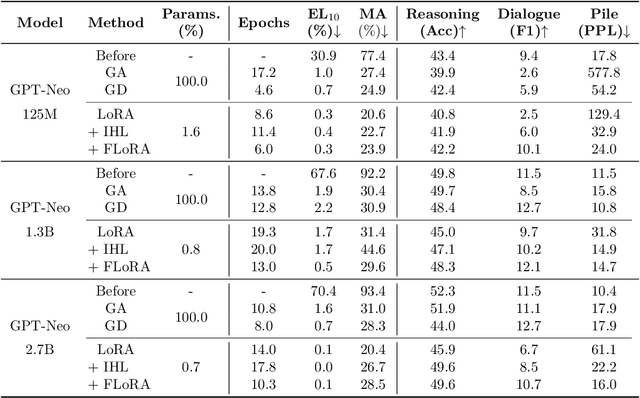

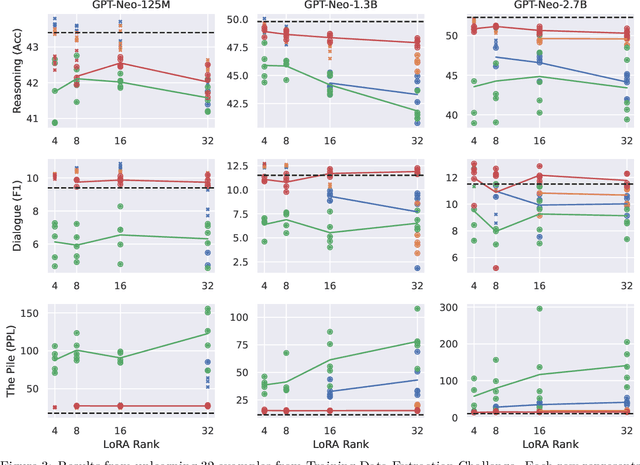
Abstract:Large Language Models (LLMs) have demonstrated strong reasoning and memorization capabilities via pretraining on massive textual corpora. However, training LLMs on human-written text entails significant risk of privacy and copyright violations, which demands an efficient machine unlearning framework to remove knowledge of sensitive data without retraining the model from scratch. While Gradient Ascent (GA) is widely used for unlearning by reducing the likelihood of generating unwanted information, the unboundedness of increasing the cross-entropy loss causes not only unstable optimization, but also catastrophic forgetting of knowledge that needs to be retained. We also discover its joint application under low-rank adaptation results in significantly suboptimal computational cost vs. generative performance trade-offs. In light of this limitation, we propose two novel techniques for robust and cost-efficient unlearning on LLMs. We first design an Inverted Hinge loss that suppresses unwanted tokens by increasing the probability of the next most likely token, thereby retaining fluency and structure in language generation. We also propose to initialize low-rank adapter weights based on Fisher-weighted low-rank approximation, which induces faster unlearning and better knowledge retention by allowing model updates to be focused on parameters that are important in generating textual data we wish to remove.
Practical and Reproducible Symbolic Music Generation by Large Language Models with Structural Embeddings
Jul 29, 2024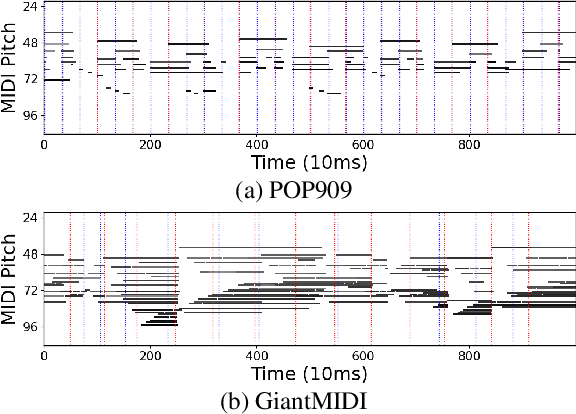

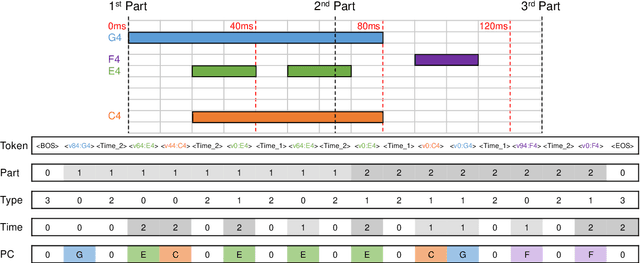

Abstract:Music generation introduces challenging complexities to large language models. Symbolic structures of music often include vertical harmonization as well as horizontal counterpoint, urging various adaptations and enhancements for large-scale Transformers. However, existing works share three major drawbacks: 1) their tokenization requires domain-specific annotations, such as bars and beats, that are typically missing in raw MIDI data; 2) the pure impact of enhancing token embedding methods is hardly examined without domain-specific annotations; and 3) existing works to overcome the aforementioned drawbacks, such as MuseNet, lack reproducibility. To tackle such limitations, we develop a MIDI-based music generation framework inspired by MuseNet, empirically studying two structural embeddings that do not rely on domain-specific annotations. We provide various metrics and insights that can guide suitable encoding to deploy. We also verify that multiple embedding configurations can selectively boost certain musical aspects. By providing open-source implementations via HuggingFace, our findings shed light on leveraging large language models toward practical and reproducible music generation.
Learning Equi-angular Representations for Online Continual Learning
Apr 02, 2024



Abstract:Online continual learning suffers from an underfitted solution due to insufficient training for prompt model update (e.g., single-epoch training). To address the challenge, we propose an efficient online continual learning method using the neural collapse phenomenon. In particular, we induce neural collapse to form a simplex equiangular tight frame (ETF) structure in the representation space so that the continuously learned model with a single epoch can better fit to the streamed data by proposing preparatory data training and residual correction in the representation space. With an extensive set of empirical validations using CIFAR-10/100, TinyImageNet, ImageNet-200, and ImageNet-1K, we show that our proposed method outperforms state-of-the-art methods by a noticeable margin in various online continual learning scenarios such as disjoint and Gaussian scheduled continuous (i.e., boundary-free) data setups.
3D Denoisers are Good 2D Teachers: Molecular Pretraining via Denoising and Cross-Modal Distillation
Sep 08, 2023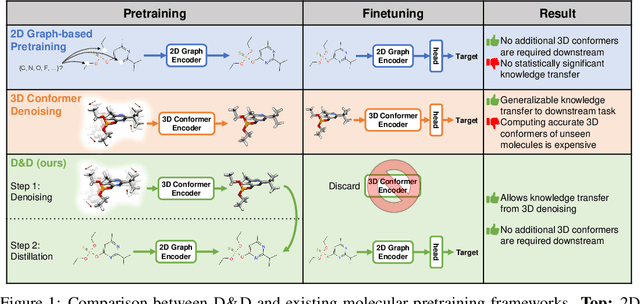
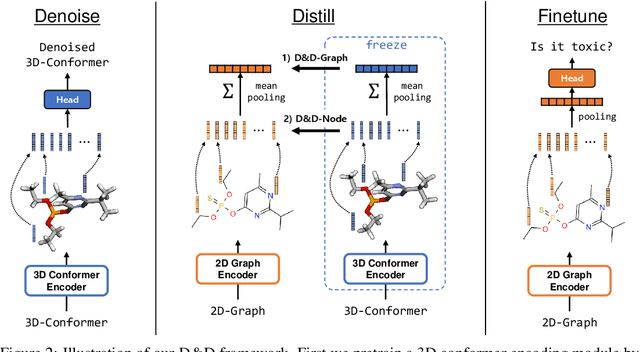

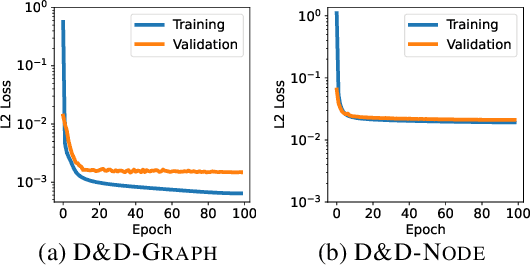
Abstract:Pretraining molecular representations from large unlabeled data is essential for molecular property prediction due to the high cost of obtaining ground-truth labels. While there exist various 2D graph-based molecular pretraining approaches, these methods struggle to show statistically significant gains in predictive performance. Recent work have thus instead proposed 3D conformer-based pretraining under the task of denoising, which led to promising results. During downstream finetuning, however, models trained with 3D conformers require accurate atom-coordinates of previously unseen molecules, which are computationally expensive to acquire at scale. In light of this limitation, we propose D&D, a self-supervised molecular representation learning framework that pretrains a 2D graph encoder by distilling representations from a 3D denoiser. With denoising followed by cross-modal knowledge distillation, our approach enjoys use of knowledge obtained from denoising as well as painless application to downstream tasks with no access to accurate conformers. Experiments on real-world molecular property prediction datasets show that the graph encoder trained via D&D can infer 3D information based on the 2D graph and shows superior performance and label-efficiency against other baselines.
Curve Your Attention: Mixed-Curvature Transformers for Graph Representation Learning
Sep 08, 2023Abstract:Real-world graphs naturally exhibit hierarchical or cyclical structures that are unfit for the typical Euclidean space. While there exist graph neural networks that leverage hyperbolic or spherical spaces to learn representations that embed such structures more accurately, these methods are confined under the message-passing paradigm, making the models vulnerable against side-effects such as oversmoothing and oversquashing. More recent work have proposed global attention-based graph Transformers that can easily model long-range interactions, but their extensions towards non-Euclidean geometry are yet unexplored. To bridge this gap, we propose Fully Product-Stereographic Transformer, a generalization of Transformers towards operating entirely on the product of constant curvature spaces. When combined with tokenized graph Transformers, our model can learn the curvature appropriate for the input graph in an end-to-end fashion, without the need of additional tuning on different curvature initializations. We also provide a kernelized approach to non-Euclidean attention, which enables our model to run in time and memory cost linear to the number of nodes and edges while respecting the underlying geometry. Experiments on graph reconstruction and node classification demonstrate the benefits of generalizing Transformers to the non-Euclidean domain.
Learning to Unlearn: Instance-wise Unlearning for Pre-trained Classifiers
Jan 27, 2023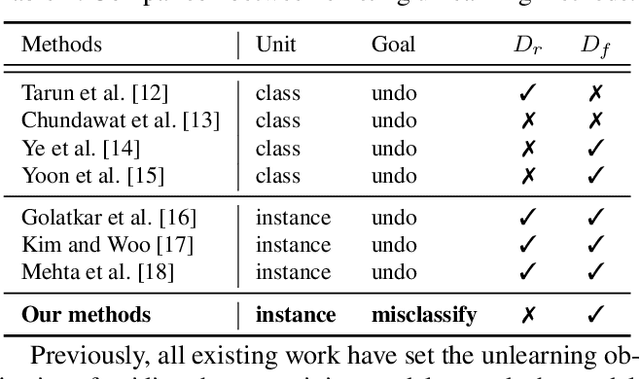
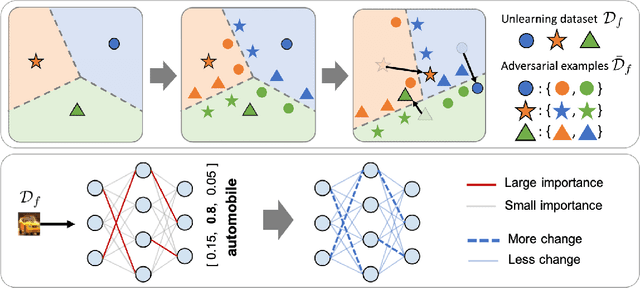
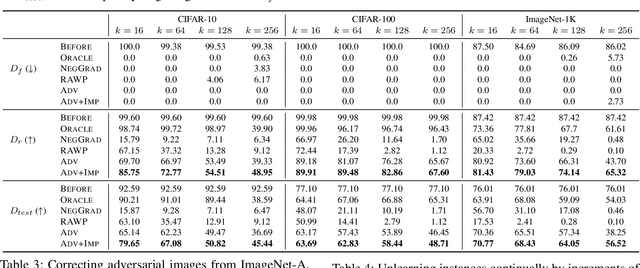

Abstract:Since the recent advent of regulations for data protection (e.g., the General Data Protection Regulation), there has been increasing demand in deleting information learned from sensitive data in pre-trained models without retraining from scratch. The inherent vulnerability of neural networks towards adversarial attacks and unfairness also calls for a robust method to remove or correct information in an instance-wise fashion, while retaining the predictive performance across remaining data. To this end, we define instance-wise unlearning, of which the goal is to delete information on a set of instances from a pre-trained model, by either misclassifying each instance away from its original prediction or relabeling the instance to a different label. We also propose two methods that reduce forgetting on the remaining data: 1) utilizing adversarial examples to overcome forgetting at the representation-level and 2) leveraging weight importance metrics to pinpoint network parameters guilty of propagating unwanted information. Both methods only require the pre-trained model and data instances to forget, allowing painless application to real-life settings where the entire training set is unavailable. Through extensive experimentation on various image classification benchmarks, we show that our approach effectively preserves knowledge of remaining data while unlearning given instances in both single-task and continual unlearning scenarios.
Transformers meet Stochastic Block Models: Attention with Data-Adaptive Sparsity and Cost
Oct 27, 2022



Abstract:To overcome the quadratic cost of self-attention, recent works have proposed various sparse attention modules, most of which fall under one of two groups: 1) sparse attention under a hand-crafted patterns and 2) full attention followed by a sparse variant of softmax such as $\alpha$-entmax. Unfortunately, the first group lacks adaptability to data while the second still requires quadratic cost in training. In this work, we propose SBM-Transformer, a model that resolves both problems by endowing each attention head with a mixed-membership Stochastic Block Model (SBM). Then, each attention head data-adaptively samples a bipartite graph, the adjacency of which is used as an attention mask for each input. During backpropagation, a straight-through estimator is used to flow gradients beyond the discrete sampling step and adjust the probabilities of sampled edges based on the predictive loss. The forward and backward cost are thus linear to the number of edges, which each attention head can also choose flexibly based on the input. By assessing the distribution of graphs, we theoretically show that SBM-Transformer is a universal approximator for arbitrary sequence-to-sequence functions in expectation. Empirical evaluations under the LRA and GLUE benchmarks demonstrate that our model outperforms previous efficient variants as well as the original Transformer with full attention. Our implementation can be found in https://github.com/sc782/SBM-Transformer .
Improving Multi-fidelity Optimization with a Recurring Learning Rate for Hyperparameter Tuning
Sep 26, 2022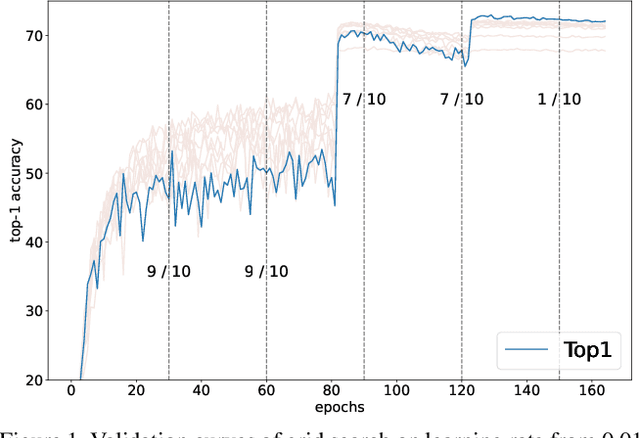
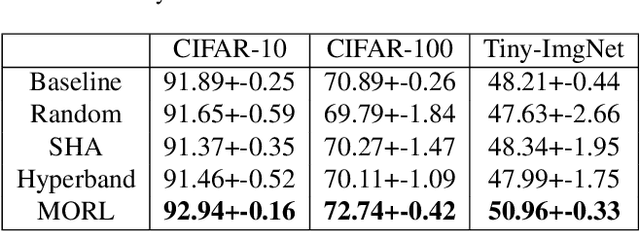
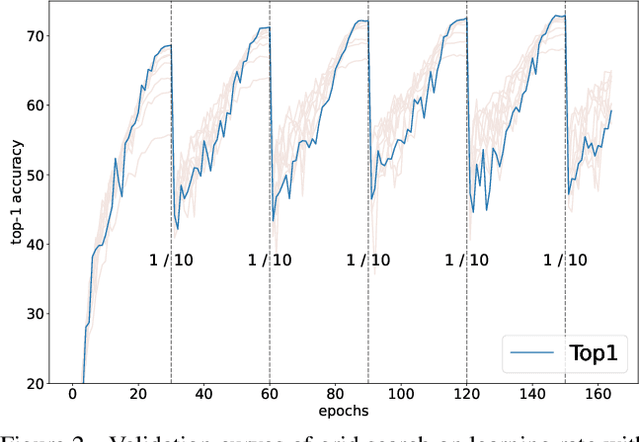

Abstract:Despite the evolution of Convolutional Neural Networks (CNNs), their performance is surprisingly dependent on the choice of hyperparameters. However, it remains challenging to efficiently explore large hyperparameter search space due to the long training times of modern CNNs. Multi-fidelity optimization enables the exploration of more hyperparameter configurations given budget by early termination of unpromising configurations. However, it often results in selecting a sub-optimal configuration as training with the high-performing configuration typically converges slowly in an early phase. In this paper, we propose Multi-fidelity Optimization with a Recurring Learning rate (MORL) which incorporates CNNs' optimization process into multi-fidelity optimization. MORL alleviates the problem of slow-starter and achieves a more precise low-fidelity approximation. Our comprehensive experiments on general image classification, transfer learning, and semi-supervised learning demonstrate the effectiveness of MORL over other multi-fidelity optimization methods such as Successive Halving Algorithm (SHA) and Hyperband. Furthermore, it achieves significant performance improvements over hand-tuned hyperparameter configuration within a practical budget.
 Add to Chrome
Add to Chrome Add to Firefox
Add to Firefox Add to Edge
Add to Edge